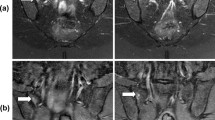Abstract
Objective
To test contrast to noise ratios (CNRs) of both diffusion-weighted (DW) images and contrast enhanced images in terms of the visual assessment of activity in sacroiliitis of ankylosing spondylitis (AS) patients.
Materials and methods
The study included 21 patients with AS. All patients were examined with STIR, FST1/Gd and DWI (b = 0,600). A total of 54 hyperintense lesions on STIR were noted in their sacroiliac joints divided into four quadrants. CNRs were calculated for all of the sequences above. A second group of patients (n = 7) with normal sacroiliac joints (SIJs) served as controls. A total of 56 CNR measurements from apparently normal subchondral bone marrow in this control group were done as well. The differences between scores were tested for significance (SPSS version 17.0) using Wilcoxon's test in which p values lower than 0.01 were considered statistically significant.
Results
In the first group with sacroiliitis, mean CNRs for STIR, FST1/Gd, DWI were 32.97, 30.16 and 24.47, respectively. Mean CNRs in the second group with normal SIJs were calculated as 3.52 , 2.99 and 3.96, respectively . There was a statistically significant difference between the CNR measurements of the first and the second group (p = 0.000).
Hyperintense lesions on STIR were depicted as "active" in the first group. Except for four lesions that were not included into the study, all of these hyperintense lesions were enhanced after contrast media administration. All of the "active" lesions were observed on DWI as well, at b = 600. No statistically significant difference between CNRs of contrast enhanced images and DWI and of contrast enhanced images and fluid sensitive sequences were found in the first group with sacroiliitis (p > 0.01).
Conclusion
The CNRs are highest on STIR, followed by contrast enhanced images and DWIs. In terms of DWI and contrast enhanced images, there is no statistically significant difference between these two. Hence, contrast enhanced imaging can be replaced by DWI for visual analysis of active sacroiliitis, which is easy to apply without adverse affects of contrast media.


Similar content being viewed by others
References
Jurik AG. Inflammatory Arthropathy – Ankylosing Spondylitis ISMRM. Hawai. 2009; 19-24.
François RJ, Gardner DL, Degrave EJ, Bywaters EGL. Histopathologic evidence that sacroiliitis in ankylosing spondylitis is not merely enthesitis. Systematic study of specimens from patients and control subjects. Arthritis Rheum. 2000;43:2011–24.
Althoff CE, Feist E, Burova E, Eshed I, Bollow M. Magnetic resonance imaging of active sacroiliitis: do we really need gadolinium? Eur J Radiol. 2009;71:232–6.
O’Hare A, Shortt C, Napier N, Eustace SJ. Bone marrow edema: patterns and clinical implications. Semin Musculoskelet Radiol. 2006;10:249–57.
Bozgeyik Z, Ozgocmen S, Kocakoc E. Role of diffusion-weighted MRI in the detection of early active sacroiliitis. AJR. 2008;191:980–6.
Sieper J, Rudwaleit M, Baraliakos X, Brandt J, Braun J, Burgos-Vargas R, Dougados M, Hermann KG, Landewé R, Maksymowych W, van der Heijde D. The Assessment of SpondyloArthritis international Society (ASAS) handbook: a guide to assess spondyloarthritis. Ann Rheum Dis. 2009;68(2):ii1–44.
Madsen KB, Jurik AG. Magnetic resonance imaging grading system for active and chronic spondylarthritis changes in the sacroiliac joints. Arthritis Care Res (Hoboken). 2010;62:11–8.
Goh L, Suresh P, Gafoor A, Hughes P, Hickling P. Disease activity in longstanding ankylosing spondylitis-a correlation of clinical and magnetic resonance imaging findings. Clin Rheumatol. 2008;27:449–55.
Braun J, Baraliakos X, Golder W, Brandt J, Rudwaleit M, Listing J, Bollow M, Sieper J, Van Der Heijde D. Magnetic resonance imaging examinations of the spine in patients with ankylosing spondylitis, before and after successful therapy with infliximab: evaluation of a new scoring system. Arthritis Rheum. 2003;48:1126–36.
Khoo MMY, Tyler PA, Saifuddin A, Padhani AR. Diffusion-weighted imaging (DWI) in musculoskeletal MRI: a critical review. Skeletal Radiol. 2011;40:665–81.
Conflict of interest
The authors declare that they have no conflict of interest.
Author information
Authors and Affiliations
Corresponding author
Rights and permissions
About this article
Cite this article
Sanal, H.T., Yilmaz, S., Kalyoncu, U. et al. Value of DWI in visual assessment of activity of sacroiliitis in longstanding ankylosing spondylitis patients. Skeletal Radiol 42, 289–293 (2013). https://doi.org/10.1007/s00256-012-1477-3
Received:
Revised:
Accepted:
Published:
Issue Date:
DOI: https://doi.org/10.1007/s00256-012-1477-3




